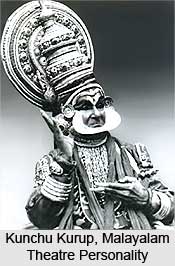 Kunchu Kurup in the role of nala 1981Kunchu Kurup was the pioneer in the renewal of Kathakali. He was born in Takazhi, in Alappuzha district in 1881. After formal school of education he started Kathakali at the age of 13. He did his training under his maternal uncles Kurichi Kochappi Panicker and Rama Panicker. A few years later, he joined the troupe of the renowned performer Mathur Kunju Pillai Panicker (1873-1929). This enhanced his acting. He later became a disciple of the famous guru, Champakkulam Sankara Pillai. Afterwards he joined Kanhangat in the Malabar region, mastering the Kalluvazhi style of Kathakali. In 1910, Kunchu Kurup married Sridevi Amma, niece of the well-known Kathakali actor Palayil Karunakara Menon, and learnt from him too, settling in Chambrakulangara near Palakkad. He was lead actor in the troupes of Kudali Nambiar, Kavungal Narayana Panicker, Punnathur Raja, and, from 1922, Manakkulam Raja. Till 1931 he was the senior teacher at their Kathakali School as well.
Kunchu Kurup in the role of nala 1981Kunchu Kurup was the pioneer in the renewal of Kathakali. He was born in Takazhi, in Alappuzha district in 1881. After formal school of education he started Kathakali at the age of 13. He did his training under his maternal uncles Kurichi Kochappi Panicker and Rama Panicker. A few years later, he joined the troupe of the renowned performer Mathur Kunju Pillai Panicker (1873-1929). This enhanced his acting. He later became a disciple of the famous guru, Champakkulam Sankara Pillai. Afterwards he joined Kanhangat in the Malabar region, mastering the Kalluvazhi style of Kathakali. In 1910, Kunchu Kurup married Sridevi Amma, niece of the well-known Kathakali actor Palayil Karunakara Menon, and learnt from him too, settling in Chambrakulangara near Palakkad. He was lead actor in the troupes of Kudali Nambiar, Kavungal Narayana Panicker, Punnathur Raja, and, from 1922, Manakkulam Raja. Till 1931 he was the senior teacher at their Kathakali School as well.
In 1931, when Vallathol Menon started Kerala Kalamandalam, Kunchu Kurup was appointed chief preceptor. He went on their Burma tour in 1935 as the main actor. Kurup excelled as Nala, Rukmangada, Kichaka, Kuchela, Hamsa, etc. The Brahmans in Santana Gopalam i.e. `Gopala, Saviour of Children` and Rukmini svayamvaram i.e. `Rukmini`s Choice of Groom`, Ravana in Balivijayam i.e. `Victor over Bali` and Rambhapravesam i.e. `Molestation of Rambha`, and Arjuna in Kalakeyavadham i.e. `Slaying of Kalakeya`, all of them are Kurup`s main roles. Many of his co-actors like Pattikkantodi Ramunni Menon liked his interpretations of these roles and learnt from him. He performed and expressed with minimum gestures but full concentration that equaled other actors` elaborations. He believed that repeated gestures of the same kind invited spectators` hatred of the character. He introduced the enactment of Rukmangada-charitam i.e. `Rukmangada`s Life` and the first and fourth days` stories of Nalacharitam i.e. `Nala`s Life`, which were not popular in Malabar. His students include Gopi Nath, Kalamandalam Krishnan Nair, Mrinalini Sarabhai, and Ram Gopal.
Kunchu Kurup was the first artist to get the Indian national award for Kathakali. He was honoured with the Padma Shri and Padma Bhushan awards, which is the highest award for an artist in India. He was the mastermind in creating fresh aesthetics of Kathakali acting or dancing, by the sublime presentation of rasa and bhava abhinaya and was also known for his pacha and kathi roles. Pacha and Kathi are the two of the five make-up codes in Kathakali characters were Kunchu Kurups speciality. The Hamsa or the swan, Kaattaala or the barbarian, Kuchela and Brahman were his notable characters. Kunchu Kurup died in the year 1970.




















